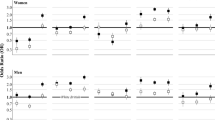Abstract
Children of immigrants are an increasing share of children living in the Netherlands. At the same time information about the situations in which these children are growing up is generally limited. Despite the wide variety of origins most studies focus on a few origin groups only. The aims of this article are therefore twofold. Main aim is to provide insight into the socio-demographic position of children of immigrants in the Netherlands on six main indicators. I will do so by including the total immigrant population in the Netherlands and separately distinguishing 60 origin groups, as well as, analyzing first and second generation children of immigrants. Data from the population registers of the Netherlands (including the total residing population) are analyzed and in some cases combined with survey sources. Findings show that children of immigrants, overall, have a less favorable position than native Dutch children regarding the socio-demographic position they grow up in. At the same time there is a huge variety between different immigrant origins and different outcome variables under study. Furthermore, the position of first and second generation children is found to vary in several respects. These findings point to the importance of paying sufficient attention to diversity and including the migration history when studying the position of children of immigrants.




Similar content being viewed by others
Notes
Some of the data in the StatLine Database are age specific; other information is available in broader age categories in which the group up to age 18 cannot be distinguished separately.
References
Arnold, F. (1997). Gender preferences for children. Demographic and Health Surveys Comparative Studies No. 23.
Bongaarts, J. (2001). Fertility and reproductive preferences in post-transitional societies. Population and Development Review, 27, 260–281.
Dagevos, J., & Gijsberts, M. (Eds.). (2007). Jaarrapport integratie 2007. The Hague: Netherlands Institute for Social Research–Social and Cultural Planning Office.
De Valk, H. A. G., & Beets, G. C. N. (2009). Kinderen in migrantengezinnen. Een statistisch portret. Demos, 25(6), 7–12.
De Valk, H. A. G., Noam, K. R., Bosch, A. M., & Beets, G. C. N. (2009). Children in immigrant families in the Netherlands: a statistical portrait and a review of the literature. Innocenti Working Paper, no. 2009-16, Florence: UNICEF Innocenti Research Centre.
Distelbrink, M. (2000). Opvoeden zonder man: Opvoeding en ontwikkeling in Creools-Surinaamse een-en tweeoudergezinnen in Nederland. Assen (the Netherlands): Van Gorcum.
Elzinga, C. H., & Liefbroer, A. C. (2007). De-standardization of family-life trajectories of young adults: a cross-national comparison using sequence analysis. European Journal of Population, 23(3/4), 225–250.
Gordon, M. M. (1964). Assimilation in American life. New York: Oxford University Press.
Hagoort, K., & Goedhuys, M. (2008). Children in migrant families 2006. Paper no. 8001. Voorburg: Centre of Policy Related Statistics, Statistics Netherlands.
Kalmijn, M., & Van Tubergen, F. (2007). Ethnic intermarriage in the Netherlands: confirmations and refutations of accepted insights. European Journal of Population, 22, 371–397.
Keuzenkamp, S., & Merens, A. (2007). De positie van allochtone vrouwen en meisjes. In J. Dagevos & M. Gijsberts (Eds.), Jaarrapport integratie 2007 (pp. 249–281). The Hague: Netherlands Institute for Social Research–Social and Cultural Planning Office.
Milewski, N. (2007). First child of immigrant workers and their descendants in West Germany: interrelation of events, disruption, or adaptation? Demographic Research, 17(29), 859–896.
Nicolaas, H., & Sprangers, A. (2007). Buitenlandse migratie in Nederland 1795–2006: De invloed op de bevolkingssamenstelling. Bevolkingstrends (no. 4/07, pp. 32–46). Voorburg: Statistics Netherlands.
Shaw, A. (2003). Immigrant families in the UK. In J. Scott, J. Treas, & M. Richards (Eds.), The Blackwell companion to the sociology of families (pp. 270–286). Oxford: Blackwell.
Statistics Netherlands (2007). Begrippen [Definitions], Statistics Netherlands, <http://www.cbs.nl/nl-NL/menu/methoden/begrippen/default.htm>
Statistics Netherlands (2009). StatLine database, <http://statline.cbs.nl/statweb/>. Accessed February 2010.
Van der Erf, R., Heering, L., & Spaan, E. (2006). Country report: Netherlands. In M. Poulain, N. Perrin, & A. Singleton (Eds.), THESIM: Towards Harmonised European Statistics on International Migration (pp. 553–564). Louvain-la-Neuve (Belgium): Presses universitaires de Louvain.
Van der Meulen, A., & de Graaf, A. (2006). Samenleven en kinderen. Bevolkingstrends 2006. Voorburg: CBS.
Van der Vliet, H. N., Wageveld, M. C. C., & Garssen, M. J. (2007). Trends in de positie van niet-westerse allochtonen. In R. P. W. Jennissen & J. Oudhof (Eds.), Ontwikkelingen in de maatschappelijke participatie van allochtonen (pp. 23–56). The Hague: Research and Documentation Centre and Statistics Netherlands.
Van Duin, C. (2009). Bevolkingsprognose 2008–2050: naar 17,5 miljoen inwoners. [Population projections 2008–2050: towards 17.5 miljon inhabitants.]. Bevolkingstrends, 2, 15–22.
Vrooman, C., & Hoff, S. (Eds.). (2004). Non-Western ethnic minorities and poverty. In: Netherlands Institute for Social Research–Social and Cultural Planning Office and Statistics Netherlands. The poor side of the Netherlands: Results of the Dutch ‘poverty monitor’ 1997–2003 (pp. 77–92). The Hague: Netherlands Institute for Social Research–Social and Cultural Planning Office and Statistics Netherlands.
Acknowledgements
This paper is based on and draws from the Dutch study within the broader project ‘Children in Immigrant Families in Eight Affluent Countries: Their Family, National and International Context’ funded by the UNICEF Innocenti Centre. For more complete and detailed information on the Dutch part of the study I refer to the online available document: De Valk et al. (2009), ‘Children in Immigrant Families in the Netherlands: A Statistical Portrait and a Review of the Literature’, Innocenti Working Paper, no. 2009-16, Florence, UNICEF Innocenti Research Centre. The study was finalized by Helga de Valk when she was a German Academic Exchange Service (DAAD) guest professor at the University of Bremen and fellow at the Hanse Institute for Advanced Study (HWK). Parts of the current work were presented in a Dutch article based on the study (De Valk and Beets 2009).
Author information
Authors and Affiliations
Corresponding author
Electronic supplementary material
Below is the link to the electronic supplementary material.
ESM 1
(XLS 54 kb)
Rights and permissions
About this article
Cite this article
De Valk, H.A.G. Children of Immigrants in the Netherlands: Growing Up in Diversity. Child Ind Res 3, 503–524 (2010). https://doi.org/10.1007/s12187-010-9080-4
Accepted:
Published:
Issue Date:
DOI: https://doi.org/10.1007/s12187-010-9080-4




